Class Bivalvia — The Bivalves (Clams and Relatives)
|
Bivalves, as their name indicates, have 2 valves or shells. Most are filter-feeders. This specimen is probably of the genus Cypricardella.
Lansing, NY
Hamilton Group, Middle Devonian, 397-385 Ma
personal collection
|
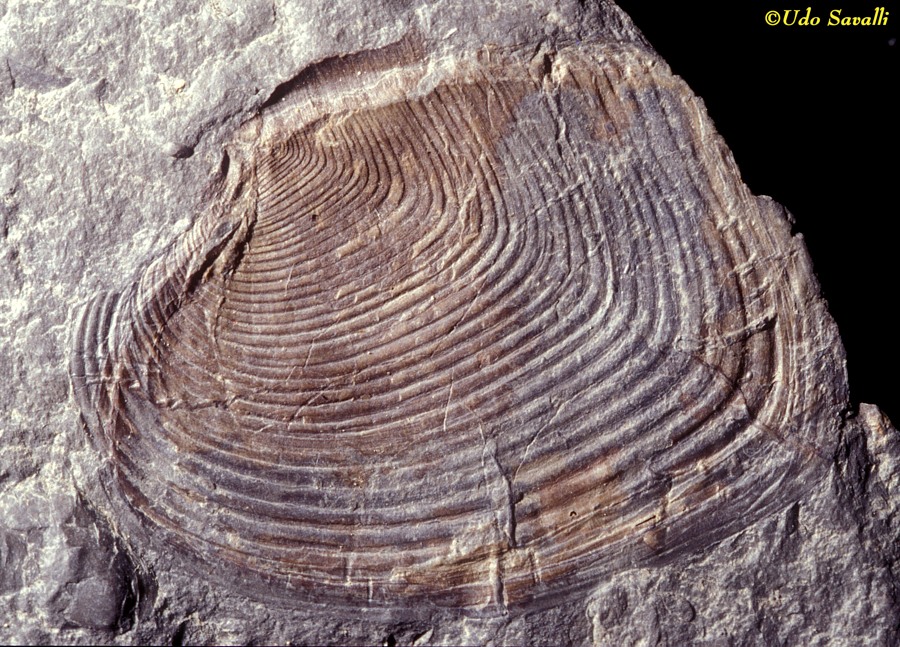
|
|
Class Gastropoda — Snails, Slugs and Relatives
|
Gastropods are the most diverse group of modern day mollusks. They are commonly preserved as internal molds, such as these.
Taylor Mill, KY
Ordovician Period
personal collection
|
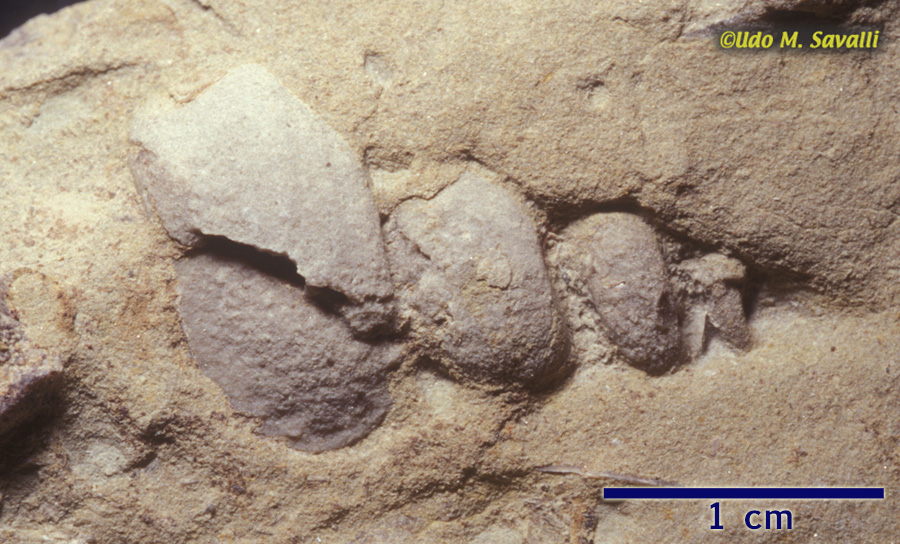
|
|
Class Cephalopoda — Octopus & Squid (Sepioids)
|
The majority of modern cephalopds (mollusks with at least 8 arms or tentacles surround a mouth with a beak) are soft bodied with an internal shell or no shell at all The living nautiluses have an external shell, as did most extinct groups.
The mostly soft-bodied forms such as this Trachyteuthis sp. squid are rarely preserved in the fossil record except in exceptional circumstances.
Lebanon
Late Cretaceous Period
Black Hills Institute Museum
|
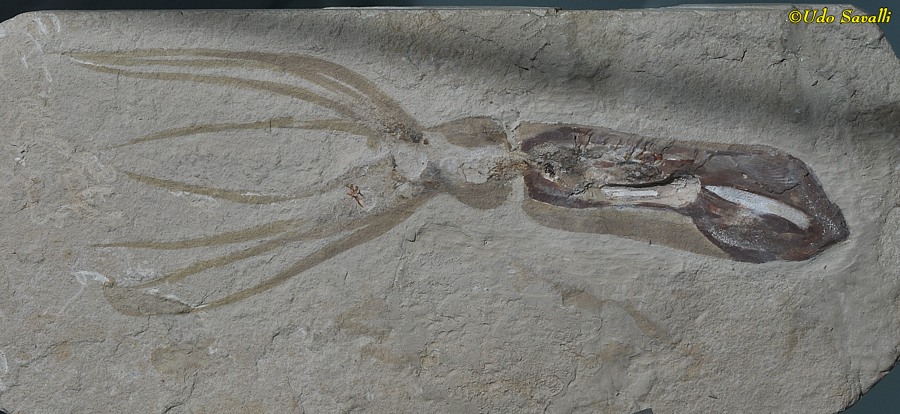
|
|
|
Octopus fossils, such as this Keuppia levanter, are even rarer than squid fossils.
Sannine Limestone, Hajula, Lebanon
Late Cretaceous, Cenomanian, 95 Ma
Black Hills Institute Museum
|
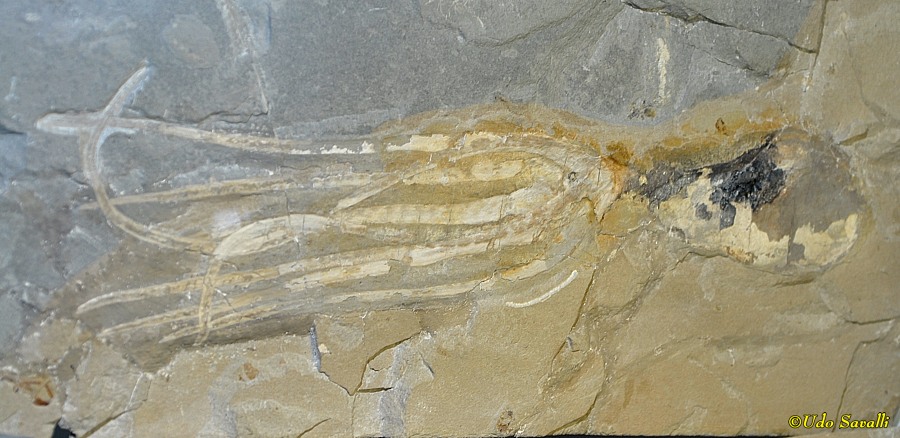
|
|
|
Belemnites are an extinct group closely related to squid and octopuses. The differed in having a hard cone-shaped internal shell.
This Phragmoteuthis concaudia belemnite had hardened hooks on its arms to capture prey.
Posiden Shale, Holzmaden, Germany
Early Jurassic Period, Lias Stage
Black Hills Institute Museum
|

|
|
|
A model of an unidentified belemnite
Wyoming Dinosaur Center
|
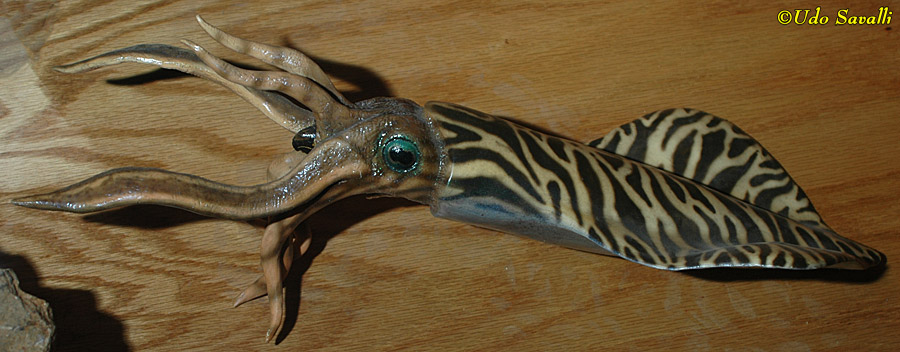
|
|
Class Cephalopoda — Nautiloids
|
The earliest cephalopods in the fossil record were the shelled Nautiloids. A few species of nautiluses survive to this day. Unlike the modern nautilus, most fossil nautiloids had straight external shells
Some nautiloids became partially coiled, such as these Lituites sp., or even completely coiled.
Sanggzhi, China
Middle Ordovician Period
Black Hills Institute Museum
|

|
|
|
Both ammonites (below) and Nautiloid shells are subdivided into a series of chambers that can be filled with gas to regulate buyoancy. During fossilization, water seeping in deposits minerals in these chambers that can crystalize. This Cymatoceras sakalavus nautiloid has been cut in half to reveal the internal chambers. Note the tube, the siphuncle, that connects the chambers. The presence of this feature is one way to distinguish nautiloids from Ammonites (below).
Sitampiky, Madagascar
Early Cretaceous Period, Albian Stage
Black Hills Institute Museum
|
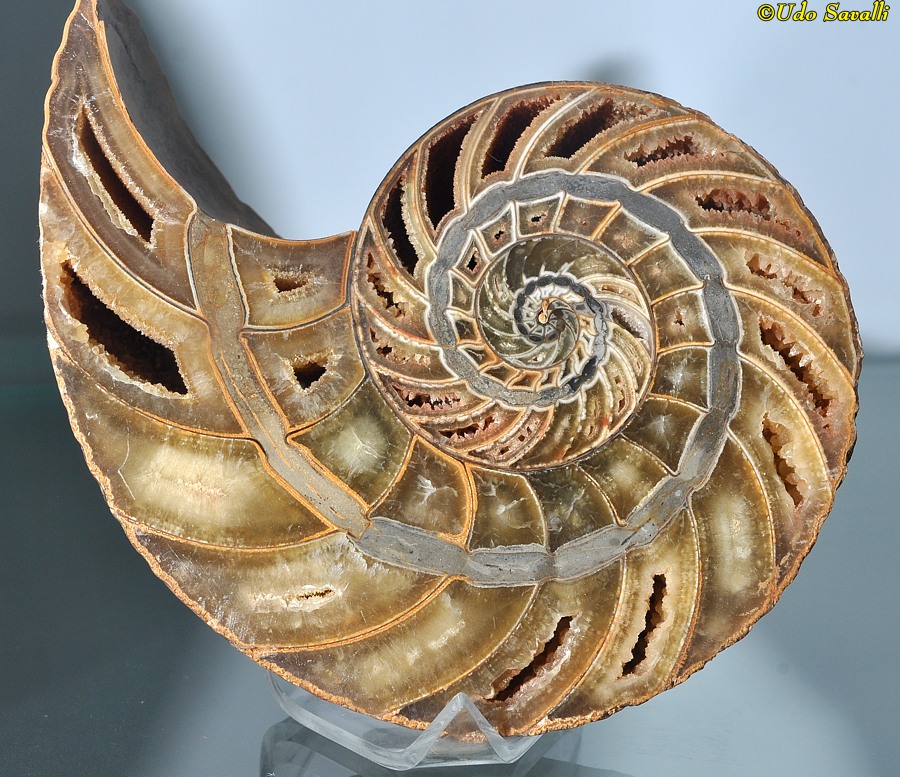
|
|
|
Goldringia cyclops, a nautiloid
Late Devonian Period
Iowa
Museum of Ancient Life, Utah
|
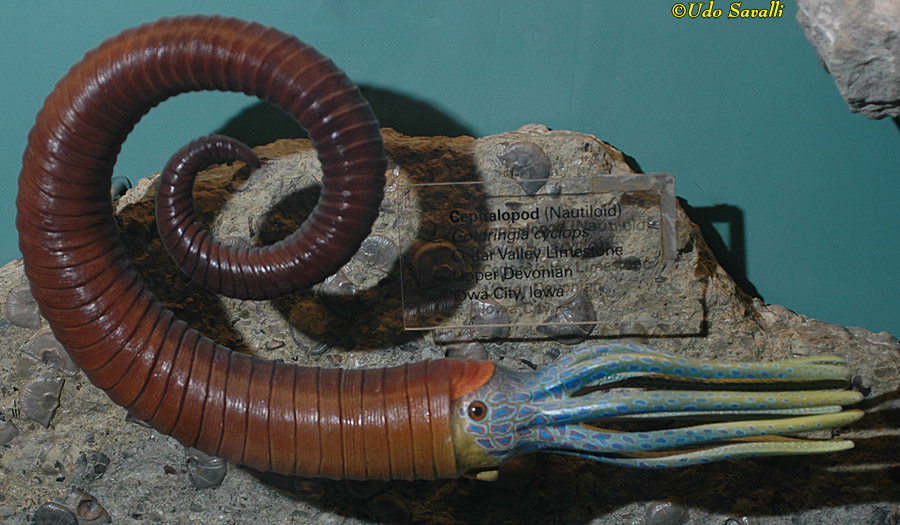
|
|
|
Endoceras sp., a nautiloid
Middle-late Ordovician Period
Museum of Ancient Life, Utah
|

|
|
|
Cooperoceras texanum, a nautiloid
Middle Permian Period of Texas
Museum of Ancient Life, Utah
|
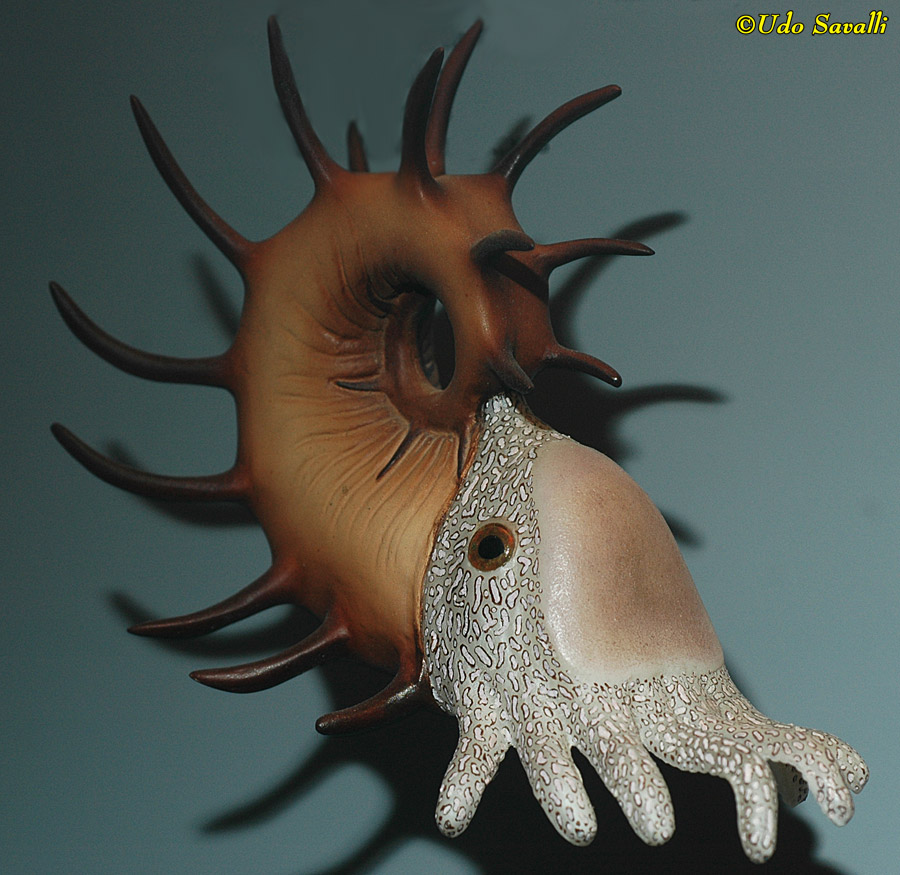
|
|
|
Mooreoceras sp. nautiloids
Carboniferous Period
Museum of Ancient Life, Utah
|

|
|
|
Amphicyrtoceras orcas, a nautiloid
Middle Silurian Period, 425 Ma; Wisconsin
Denver Museum of Science & Nature
|
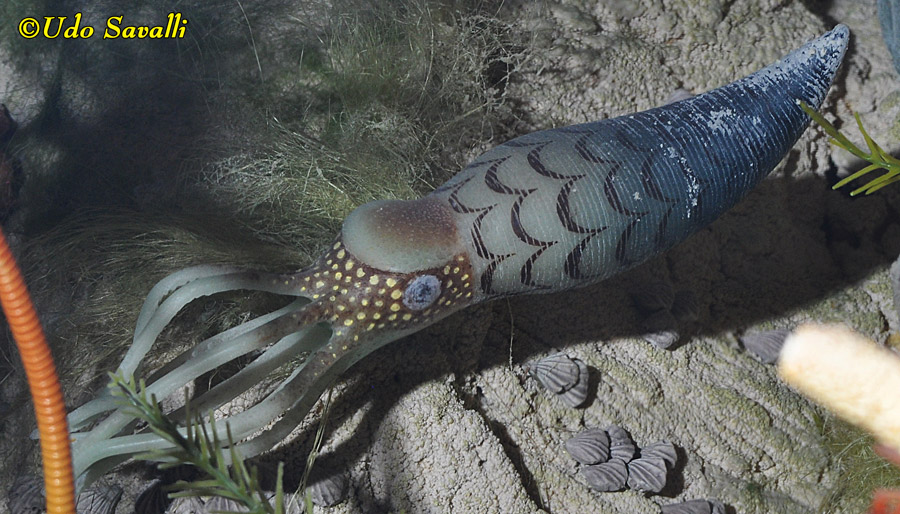
|
|
|
Uranoceras hercules nautiloid capturing a Gravicalymene trilobite
Middle Silurian Period, 425 Ma; Wisconsin
Denver Museum of Science & Nature
|
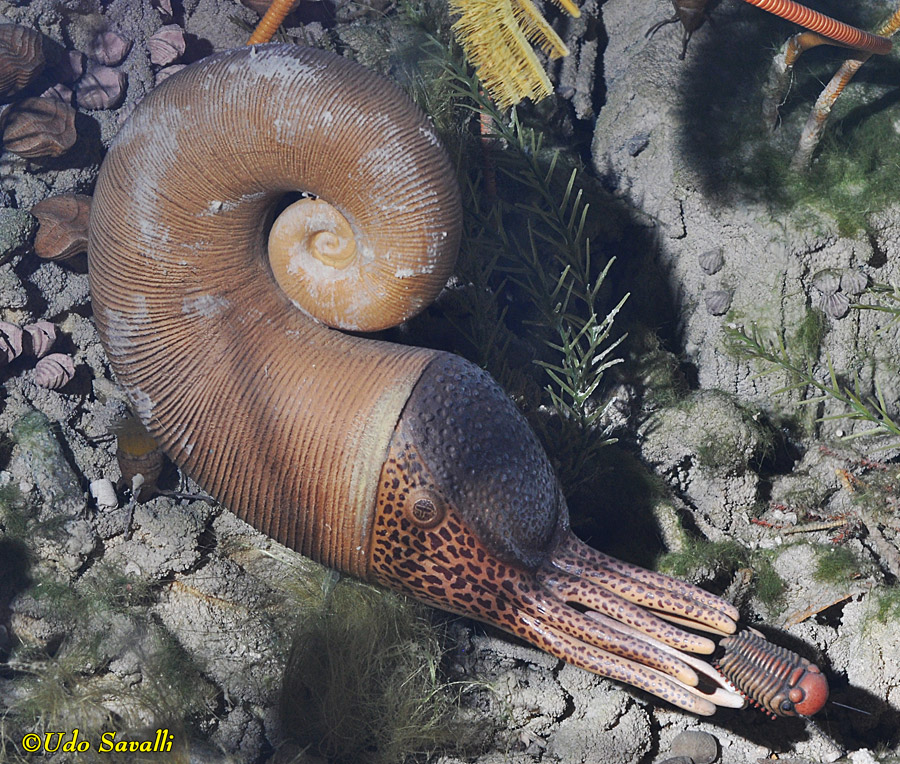
|
|
|
A typical straight-shelled nautiloid, Dawsonoceras annulatum (top) and the unusual coiled nautiloid, Phragmoceras nestor, atop the blue tabulate coral. Other animals shown include a trilobite, brachiopods, and several echinoderms.
Middle Silurian Period, 425 Ma; Wisconsin
Denver Museum of Science & Nature
|
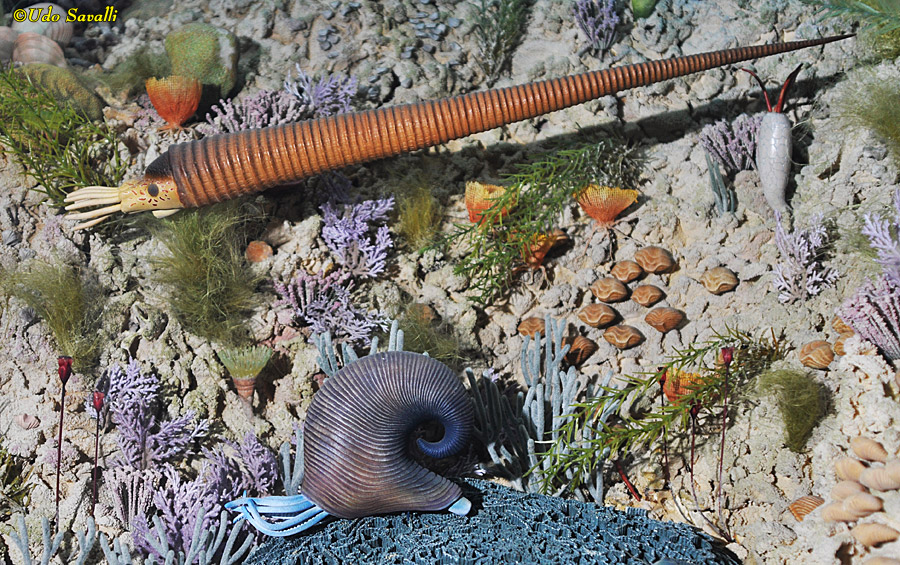
|
|
|
Michelinoceras normale, a nautiloid
Devonian Period, 370 Ma
Museum of the Rockies
|
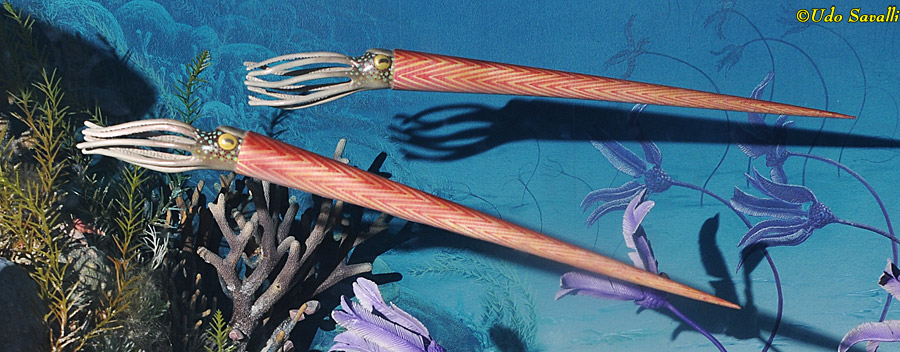
|
|
Cephalopoda: Ammonitida — The Ammonites
|
Ammonites are an extinct subgroup of cephalopod mollusks. Like the nautiloids, from which they are derived, they had an external shell. Their shell was usually tighly coiled but there were various exceptions.
Ammonite shells were often covered in bumps and ridges, perhaps to reduce predation, such as in these two Hoploscaphites spedeni shells
Black Hills Institute Museum
|
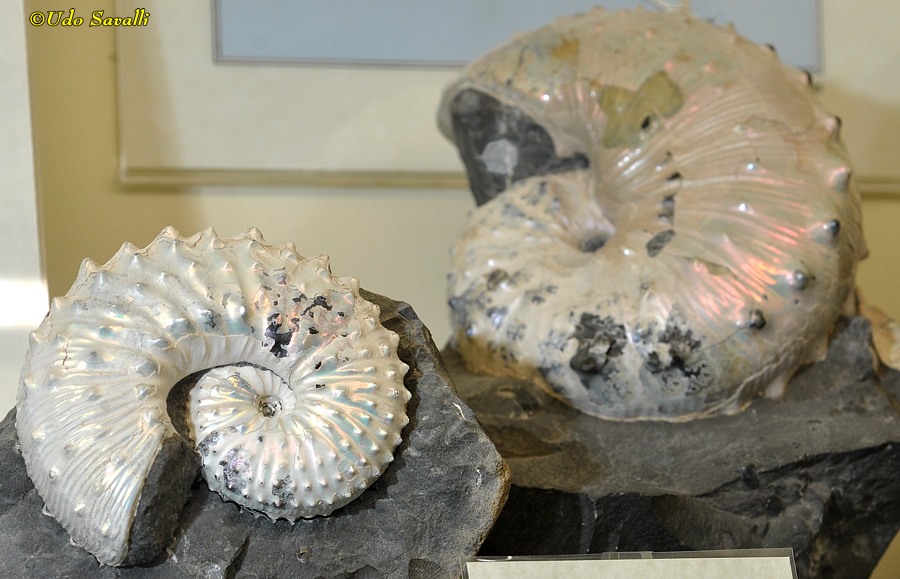
|
|
|
The original aragonite (type of calcium carbonate) mineral is often replaced during fossilization. In some cases, the replacement mineral can be irridescent and colorful and is considered a gemstone (ammolite). This specimen is Hoploscaphites nebrascensis.
Black Hills Institute Museum
|
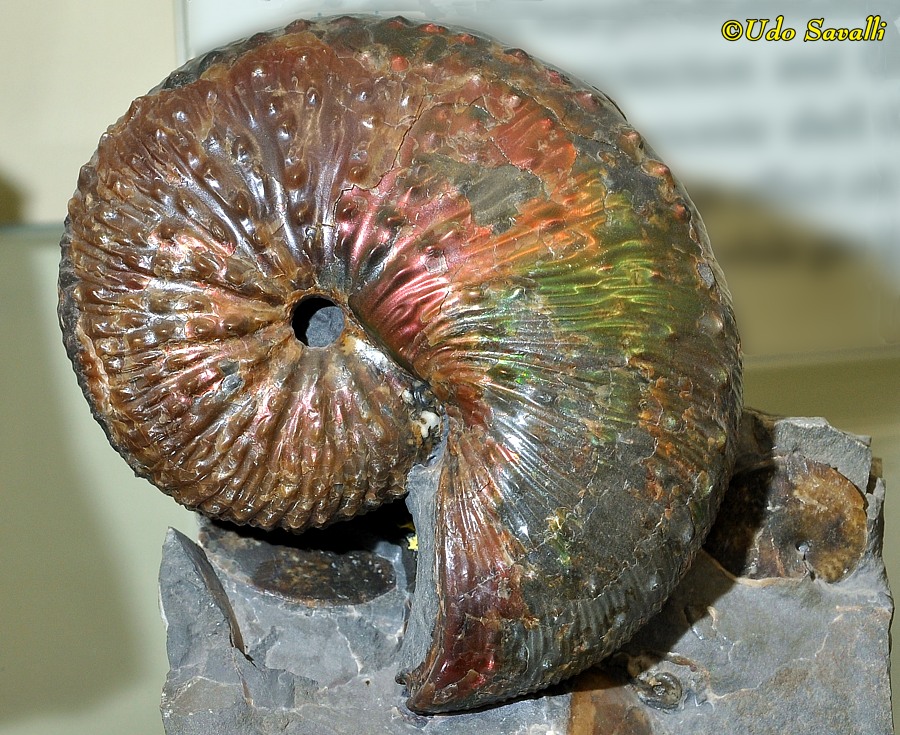
|
|
|
This Kosmoceras sp. shows the internal chambers of ammonite shells (only the last chamber, in this fossil where there is solid rock, is occupied by the living animal). The walls (septa) of ammonite chambers are convoluted and complex, unlike the much simpler walls of the nautiliods (note also the lack of a siphuncle).
Russia
Late Jurassic Period, 160 Ma
Wyoming Dinosaur Center
|
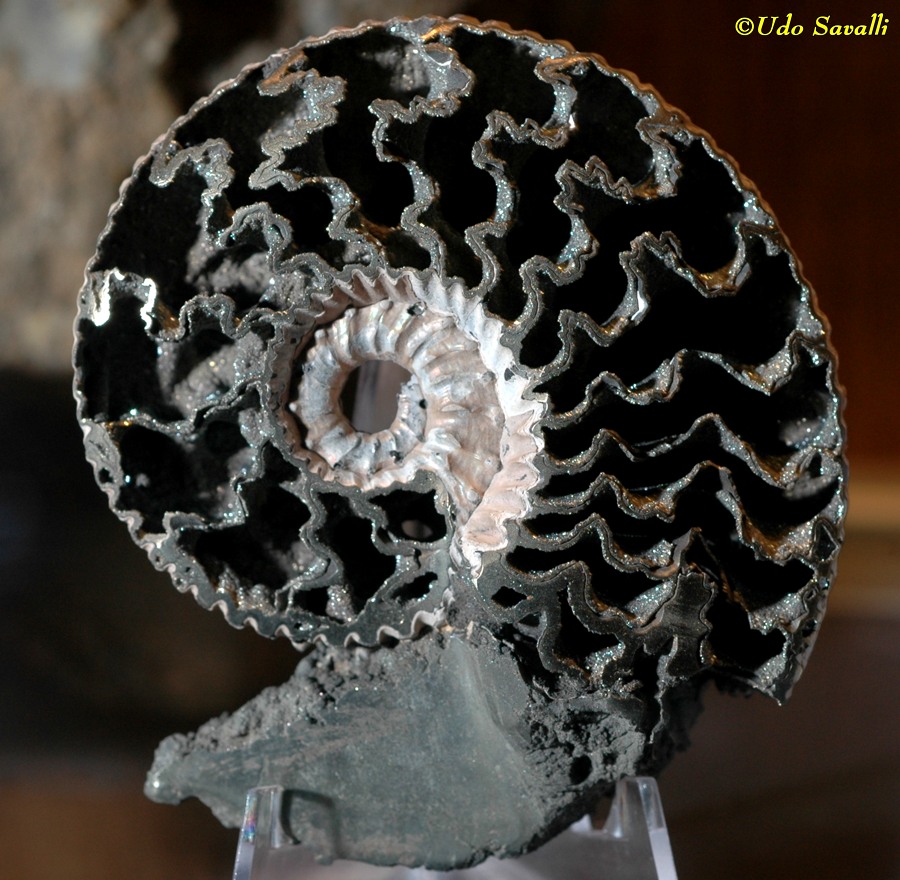
|
|
|
The shell is often eroded away during fossilization, revealing the complex suture patterns made by the internal septa, as in this Sphenodiscus sp. (only a small bit of shell is present near the main body cavity). The patterns made by these sutures are used to classify ammonites.
Fox Hills Formation, South Dakota
Late Cretaceous Period, Maastrichtian Stage
Black Hills Institute Museum
|

|
|
|
Placenticeras meeki ammonite, showing intricate suture patterns.
Late Cretaceous, Campanian Stage
Pierre Shale, Meade Co., SD
Black Hills Institute Museum
|
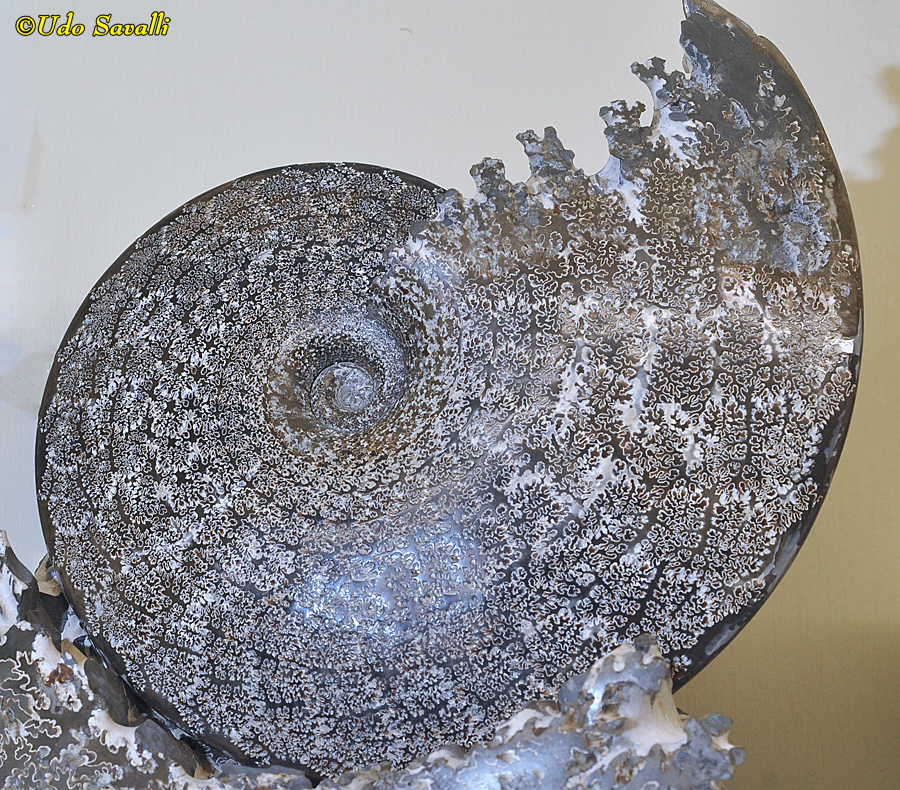
|
|
|
Ammonites that have shapes other than the traditional coiled shape are called heteromorph ammonites. Didymoceras cheyennense is on the left and Exiteloceras jenneyi is on the right.
Late Cretaceous, Campanian Stage
Pierre Shale, Montana
Black Hills Institute Museum
|
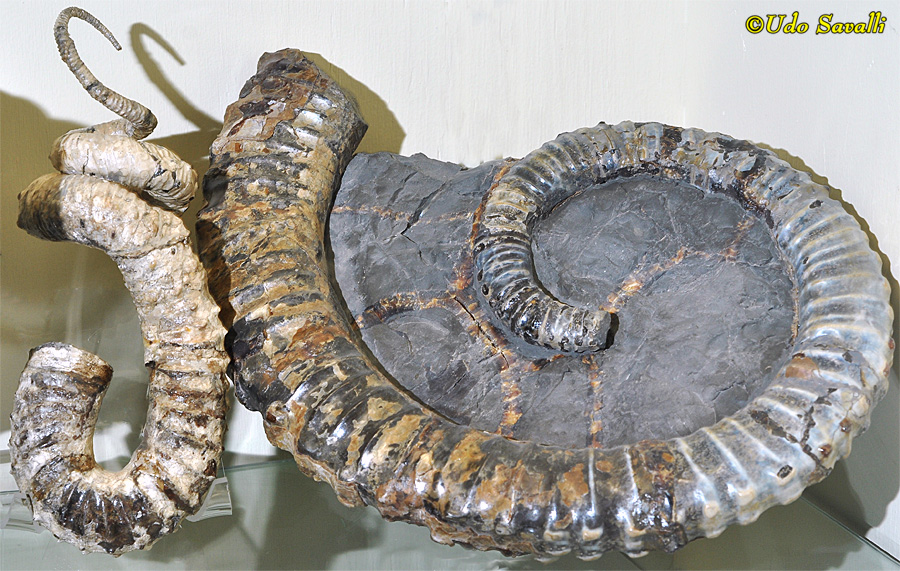
|
|
|
The heteromorph ammonite Ancyloceras waageni
Volga River, Russia
Early Cretaceous, Albian Stage
Black Hills Institute Museum
|
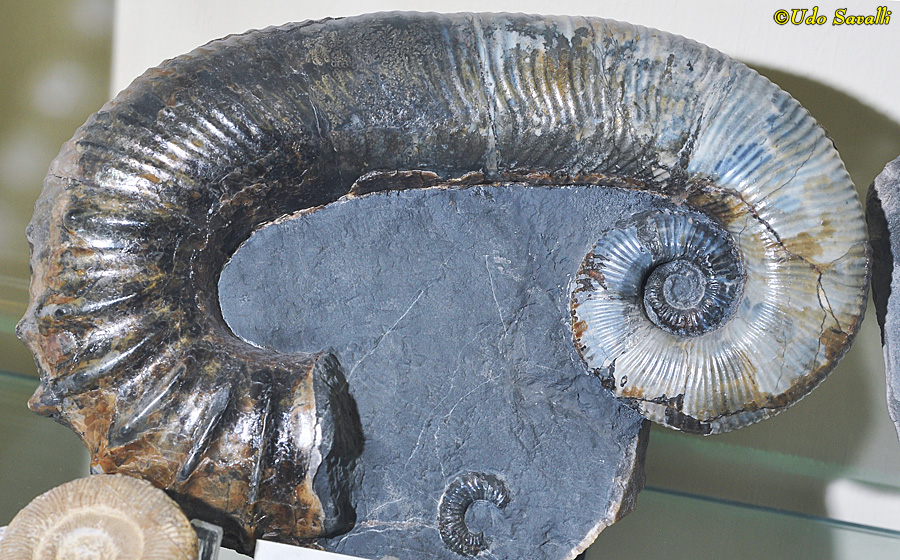
|
|
|
Exiteloceras jenneyi heteromorph ammonite.
Carter Co., Montana
Late Cretaceous, Upper Campanian Stage
Black Hills Institute Museum
|
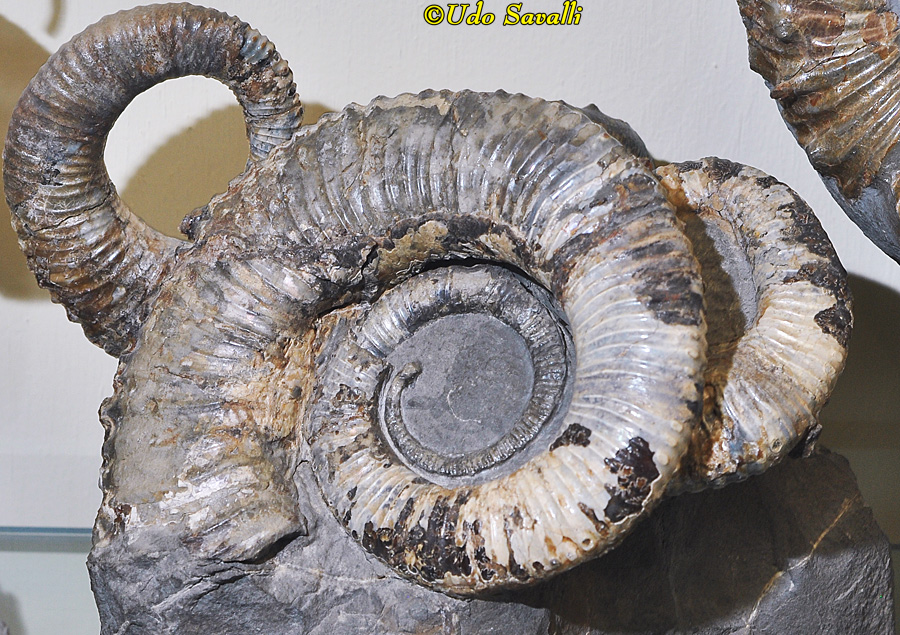
|
|
|
Titanites sp., an ammonite
Jurassic Period of Europe
Museum of Ancient Life, Utah
|

|
|
|
Placenticeras sp., an ammonite
Late Cretaceous Period, 70 Ma
Museum of Ancient Life, Utah
|
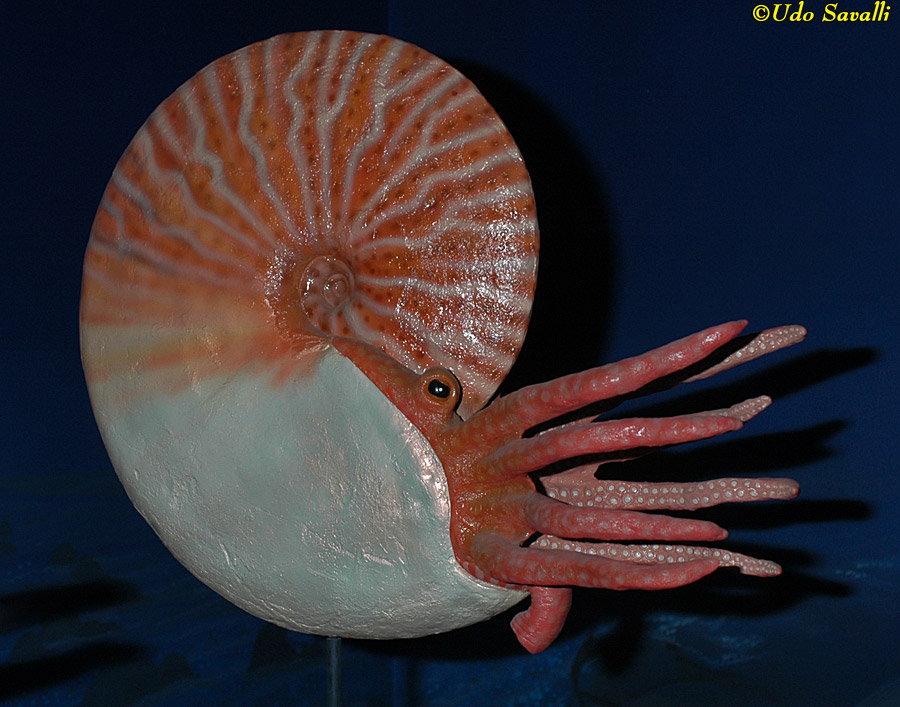
|
|
|
Baculites grandis, a straight-shelled ammonite
Late Cretaceous Period, 66 Ma; Wyoming
Museum of Ancient Life, Utah
|
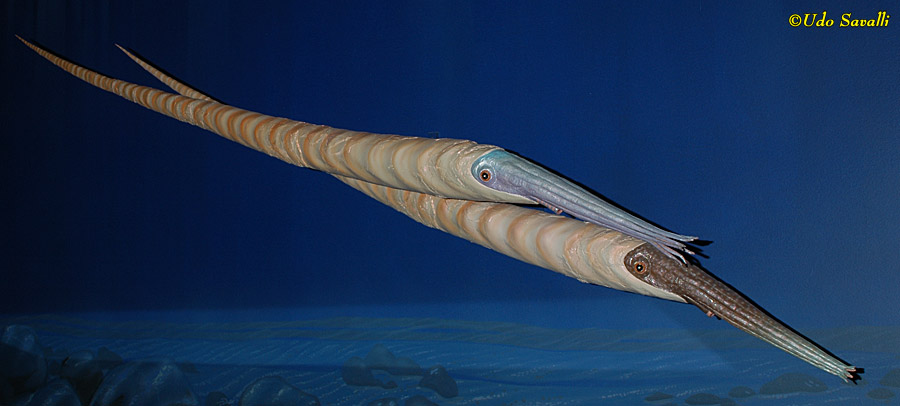
|
|
|


























